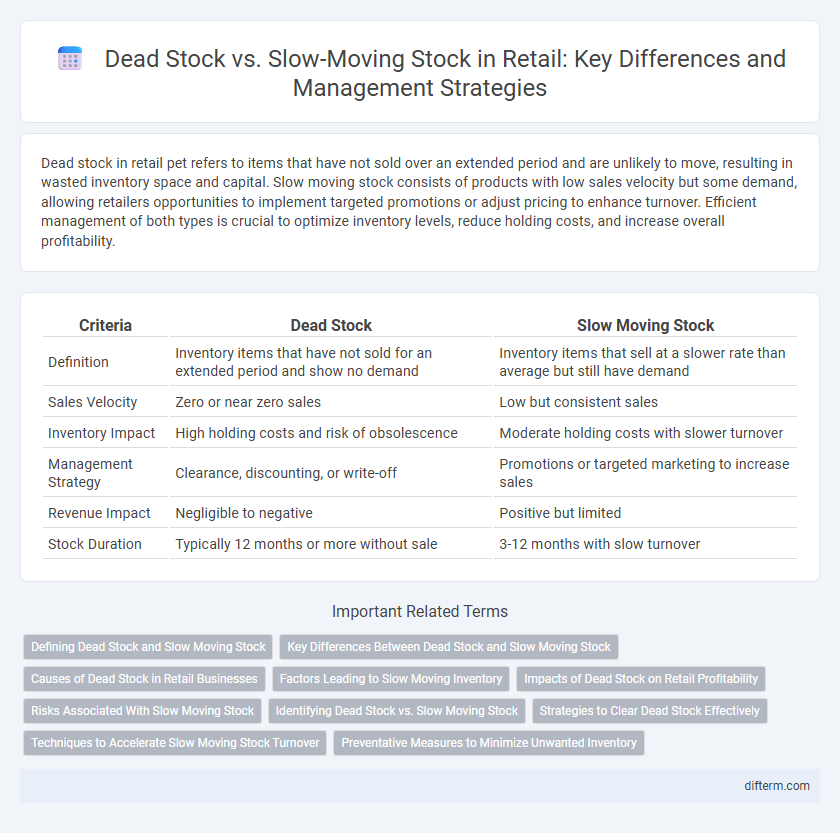Dead stock in retail pet refers to items that have not sold over an extended period and are unlikely to move, resulting in wasted inventory space and capital. Slow moving stock consists of products with low sales velocity but some demand, allowing retailers opportunities to implement targeted promotions or adjust pricing to enhance turnover. Efficient management of both types is crucial to optimize inventory levels, reduce holding costs, and increase overall profitability.
Table of Comparison
| Criteria | Dead Stock | Slow Moving Stock |
|---|---|---|
| Definition | Inventory items that have not sold for an extended period and show no demand | Inventory items that sell at a slower rate than average but still have demand |
| Sales Velocity | Zero or near zero sales | Low but consistent sales |
| Inventory Impact | High holding costs and risk of obsolescence | Moderate holding costs with slower turnover |
| Management Strategy | Clearance, discounting, or write-off | Promotions or targeted marketing to increase sales |
| Revenue Impact | Negligible to negative | Positive but limited |
| Stock Duration | Typically 12 months or more without sale | 3-12 months with slow turnover |
Defining Dead Stock and Slow Moving Stock
Dead stock refers to inventory that remains unsold for an extended period, often obsolete or out of season, with little to no demand, rendering it difficult to sell. Slow moving stock consists of products that sell at a much slower rate compared to other inventory but still have some demand and potential for turnover. Properly identifying dead stock versus slow moving stock helps retailers optimize inventory management, reduce carrying costs, and improve cash flow.
Key Differences Between Dead Stock and Slow Moving Stock
Dead stock refers to inventory that remains unsold for an extended period with little to no demand, often becoming obsolete or expired, while slow moving stock consists of items that sell at a much slower pace than expected but still generate occasional sales. Dead stock typically ties up capital and incurs storage costs without revenue, whereas slow moving stock may be managed through strategic promotions or discounts to accelerate turnover. Understanding the distinction helps retailers optimize inventory management, reduce holding costs, and improve cash flow efficiency.
Causes of Dead Stock in Retail Businesses
Dead stock in retail businesses often results from inaccurate demand forecasting, leading to excessive inventory that fails to sell. Changes in consumer preferences and seasonal fluctuations also contribute to accumulating unsold merchandise. Ineffective marketing strategies and poor inventory management systems further exacerbate the buildup of dead stock.
Factors Leading to Slow Moving Inventory
Inefficient demand forecasting, seasonal fluctuations, and poor product assortment significantly contribute to slow-moving inventory in retail. Excessive stock levels driven by inaccurate sales predictions cause products to remain unsold on shelves for extended periods. Consumer preferences shifts and inadequate marketing efforts further exacerbate inventory stagnation, increasing carrying costs and reducing profitability.
Impacts of Dead Stock on Retail Profitability
Dead stock ties up significant capital and incurs carrying costs, reducing overall retail profitability by limiting cash flow available for new merchandise investment. Accumulated unsold inventory leads to markdowns and clearance sales, further eroding profit margins and depressing brand value. Inefficient dead stock management disrupts supply chain optimization, causing increased storage expenses and operational inefficiencies in retail environments.
Risks Associated With Slow Moving Stock
Slow moving stock ties up valuable capital and storage space, increasing holding costs and reducing overall profitability in retail operations. Prolonged inventory stagnation heightens the risk of obsolescence, resulting in markdowns and write-offs that can severely impact financial performance. Inefficient management of slow moving stock disrupts cash flow and limits the ability to invest in high-demand products, ultimately affecting customer satisfaction and market competitiveness.
Identifying Dead Stock vs. Slow Moving Stock
Dead stock consists of inventory that has not sold or moved for an extended period, often exceeding 12 months, indicating poor demand or obsolescence. Slow moving stock refers to items with low turnover rates but occasional sales, typically known by analyzing inventory aging reports and sales velocity metrics. Identifying these categories accurately involves tracking SKU performance, stock aging, and market trends to optimize inventory management and reduce holding costs.
Strategies to Clear Dead Stock Effectively
Implement targeted discount campaigns and bundle dead stock with popular items to accelerate sales and reduce inventory holding costs. Employ data analytics to identify patterns and adjust purchasing decisions, minimizing future dead stock accumulation. Partner with liquidation channels or donate excess inventory to clear unsold items efficiently while maintaining brand reputation.
Techniques to Accelerate Slow Moving Stock Turnover
Implementing dynamic pricing strategies and targeted promotions effectively accelerates slow-moving stock turnover by incentivizing customer purchases. Utilizing inventory analytics to identify patterns enables precise markdowns and bundling offers that enhance product appeal. Integrating omnichannel sales approaches broadens market reach, transforming slow movers into active revenue generators in retail environments.
Preventative Measures to Minimize Unwanted Inventory
Implementing accurate demand forecasting and leveraging real-time sales data analytics can significantly reduce dead stock and slow-moving inventory in retail. Regular inventory audits and dynamic pricing strategies help identify and promote slow sellers before they become obsolete. Collaborating closely with suppliers to adopt flexible replenishment schedules ensures stock levels align with current market demand, minimizing excess inventory risk.
dead stock vs slow moving stock Infographic

 difterm.com
difterm.com